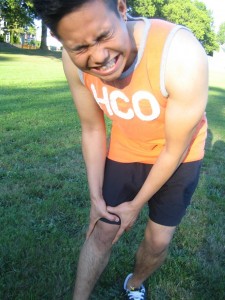Water in the knee is the excessive accumulation of fluid in or around the knee joint which is also called as effusion in the knee joint. It can be caused by trauma, injuries due to overuse as well as some diseases. In determining the cause of water in the knee, the fluid has to be tested for infection, injury or a disease. Once some of the fluid is removed, the pain and stiffness caused by water in the knee is minimized. If you want to learn more about this condition, click here.
[youtube url=”https://www.youtube.com/watch?v=pZJH3Hje1Zs” width=”200″ height=”220″]Symptoms
- The flesh found around the kneecap is swelling.
- There is stiffness or difficulty in bending or straightening the leg due to the fluid in the knee.
- There is severe pain in the knee when bearing weight on it.

Causes
Water in the knees can be caused by different types of problems like traumatic injuries to certain health conditions and diseases.
Some traumatic injuries that cause build-up of fluid found around the knee joints include a meniscus tear, tearing of the ligaments, broken bones and overuse injuries.
Some diseases and conditions that can cause fluid build-up around the knee joints include infections, bursitis, cysts, gout as well as osteoarthritis, bleeding disorders, rheumatoid arthritis, pseudo gout and tumors.
Untreated water in the knee infection can cause difficulty during movement, and the swelling caused by infection can destroy the joints.
Treatment and home remedies
- Avoid engaging weight-bearing activities when the knee is still painful and swelling.
- Apply cold compress on the knee for 15 to 20 minutes every two to four hours or use bags of ice or a pack of frozen vegetables from the freezer. This therapy can help in minimizing swelling and pain. When applying cold compress on the knee, elevate the knee higher than the level of the heart by using pillows to make the person comfortable.
- Use over-the-counter pain reliever like ibuprofen to help relieve knee pain.
- Walk on a regular basis to make the joints remain flexible and can prevent the development of arthritis in the joints.
- Drink 8 glasses of water every day to help flush out the toxins in the body. The individual will less likely develop fluid in the knees.
- Perform some weight lifting to build up muscles in the area and strengthen the knees to fight the effects of arthritis and joint effusion.
- Eat a diet high in leafy greens that has vitamin B6 since it helps in reducing swelling of the tissues and some relief from joint effusion.
- Maintain proper posture to help in reducing pressure on the joints.
Preventive measures
- Take the medications that the doctor prescribes in treating the conditions or diseases that caused water in the knee infection.
- Wear knee braces when engaging in sports training or start physical therapy.
- In order to strengthen the thigh muscles, a physical therapist should be consulted so that exercises to strengthen these muscles can be started as well as provide support to the knee.
- Select an activity or exercise that does not involve continuous weight-bearing stress on the knee joints such water aerobics or swimming.